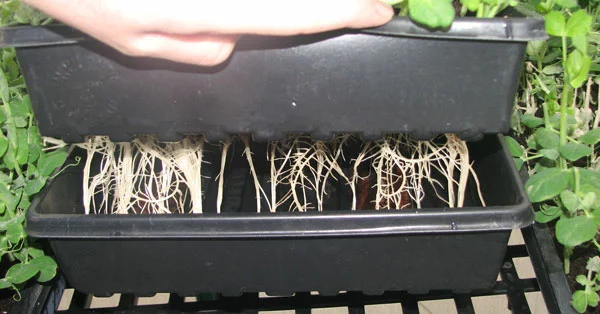I've tried lots of different hydroponics methods. While all of them work well, none of them addressed the exact needs that have. I want the following out of a hydroponics setup:
- Low maintanence
- Easy to find parts at local stores
- High yield
- Leak proof for indoor use
- Simple
- Inexpensive
Based on the above requirements I have devised a novel approach to growing hydroponics. The method that I came up works great for me. Here are my pea shoots planted using this method. If you haven't grown pea shoots for augmenting your salads then you're really missing out.
Pea Shoots
These 3 trays of pea shoots were enough to augment salads for two people during the winter. The PVC standoffs in this setup are much shorter than what I describe below, and I do not recommend making your standoffs short like this. Read on for more info about PVC standoffs. I have gotten excellent yeilds on my pea shoots, lettuce, mesclun mix, and argula.
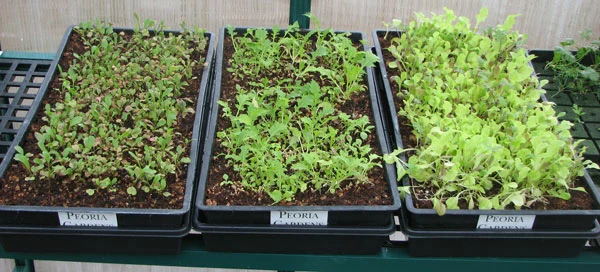
Lettuce does very well in trays like this. The thing that I really like about it is there are no leak points where you can make a mistake and accidentally water your carpet. The other thing that I like about it is the plants grow in a 11"x22" container, which is perfect for many grow lights, including 48" fluorescent tubes; I put 2 trays under 4 tubes and it's a perfect fit.
Black Plastic Trays
You'll want 2 kinds: seed starting and perforated. The seed starting trays are easy to find. They are usually about $1 each at your local nursery. These are seed starting trays. They should be easy to find and cost about $1-$2 each. These are perforated trays. If you can't find something like this then just take a seed starting tray and poke at least 100 holes in it.
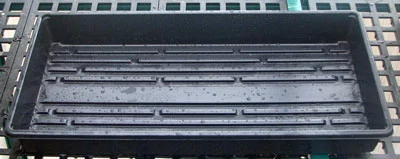
The second kind of tray might be kind of hard to find. I'm not sure what these are called, but plant trays is the name that comes to mind. If you can't find these at your local nursery then just take a seed starting tray and drill at least 100 holes in it.

PVC pipe
We need some spacers to hold the perforated trays above the seed starting trays. PVC pipe works nicely. You can use anything you want, but I like PVC pipe because it is cheap and easy to clean. It can be white, grey, black and it can be schedule 40 or 80. I like to use 1.5" pipe. Cut it into 1.5" long pieces, 6 per tray that you are going to setup. Here are some PVC pipes cut into littleÃÂ pvc standoffs.
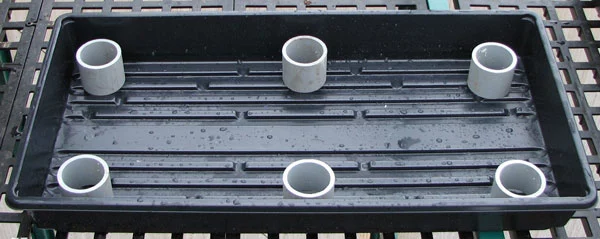
This is an example of what your PVC pipe pieces should look like. I call these pieces standoffs. They should be roughly 1.5" long each. In the end you are going to put the two trays together like this. But first we have to fill the perforated tray with media.
Final Assembly Example
Here is what the final assembly will be like.
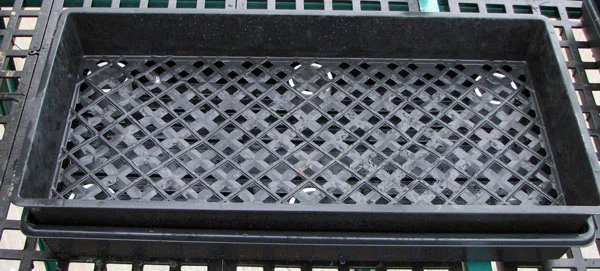
Here is what the final assembly will be like.
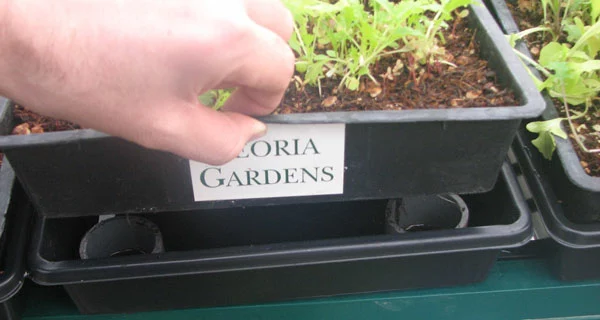
Growing Media
I like to use a mix of coco coir and perlite. Anywhere from 50/50 to 75% coco 25% perlite will work. If you are using the General Hydroponics bricks (1 brick expands to 3-1/2 gallons), then plan on 1 brick per planting tray. Mix in perlite to fit. You can rehydrate the coco coir with a very diluted nutrient solution if you want to, but it's not at all necessary. In fact I've messed up more batches by mixing in nutes at the seedling stage than I can count. When in doubt, just start with plain tap water. Here's a compressed brick of coco coir.

After soaking it in water you get expanded coco coir.
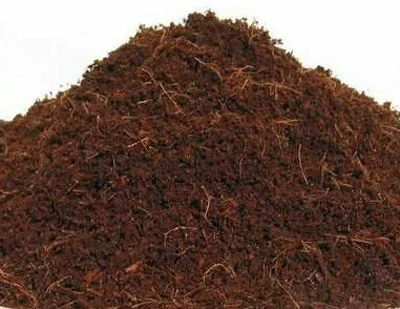
Once it expands it's light and fluffy. This is one of the best media for hydroponics.
Coco-coir and perlite mix
Perlite is available in a plastic bag at your local garden center. Mix the coco coir and perlite together and you have perfect media to grow in.

You can mix coco-coir and perlite together to make a very nice growing medium. Mix roughly equal parts and it should look something like this.
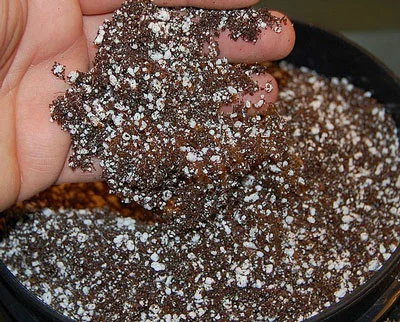
Putting It All Together
First off, make sure that everything plastic is clean. I usually wash with water and a scrubbie. I put about 2-3 gallons of water in a 5 gallon bucket and put in a small glug of bleach, and then I use the bleach water to wet everything. Then I thoroughly rinse the bleach water off.

Fill the perforated seed tray with your media. If you use coco coir it will not fall through the holes too much, but you might want to do this outside because it will be very wet and drippy. You don't have to pack the coco in there, just scoop handfuls and put it in looslely. Put the PVC pipe pieces in the seed starting tray on end like this:

Put one tray inside the other and you are ready to plant. ÃÂ
Seeding
If I'm planting basil, lettuce, spinach, cillantro, chervil, parsley, chives or any other small to medium sized seed then I usually reserve about 2 handfuls of coco coir for covering my seeds with. If I'm planting peas for pea shoots then I reserve about 4 large handfuls. I like to spread my seeds out about twice as dense as the manufacturer recomends, and then thin later. After spreading them out I put the remaining coco coir on top and pat it down. Then I water them well with a squirt bottle. Old dish soap bottles work great for this.
Germination
Cover your seends with either plastic wrap, or a humidity dome sold for this purpose. Put them in a warm place to germinate, unless they are lettuce which likes it cold. I usually just put them under the grow lights set to 16 hours of light and forget about them for 3 to 5 days. You really won't have to do anything for about a week. After a week or two you will have seedlings popping up. Take of the humidity dome when they start to get their first set of true leaves.
Care For Your Plants
After they have their first set of true leaves it's time to start feeding them. Up until now you most likely have not needed to water them at all because the humidity dome kept all of the water in. Use a quality hydroponic fertilizer such as Pure Blend Pro Grow mixed at the rate listed on the bottle.

You will not have to water that often at first, maybe once per week. After a couple of months you may have to water every 3 days. One of the great things about this method is if you over water it just drains down into the pan below instead of drowning the roots. Eventually your roots will grow down in to the pan and use that water up furthur extending the time between watering.
Pea Shoot Roots
If you want to go 2 weeks without watering then put an aquarium airstone in the bottom tray and fill it up with nutrient solution (only after the roots have grown that far).
